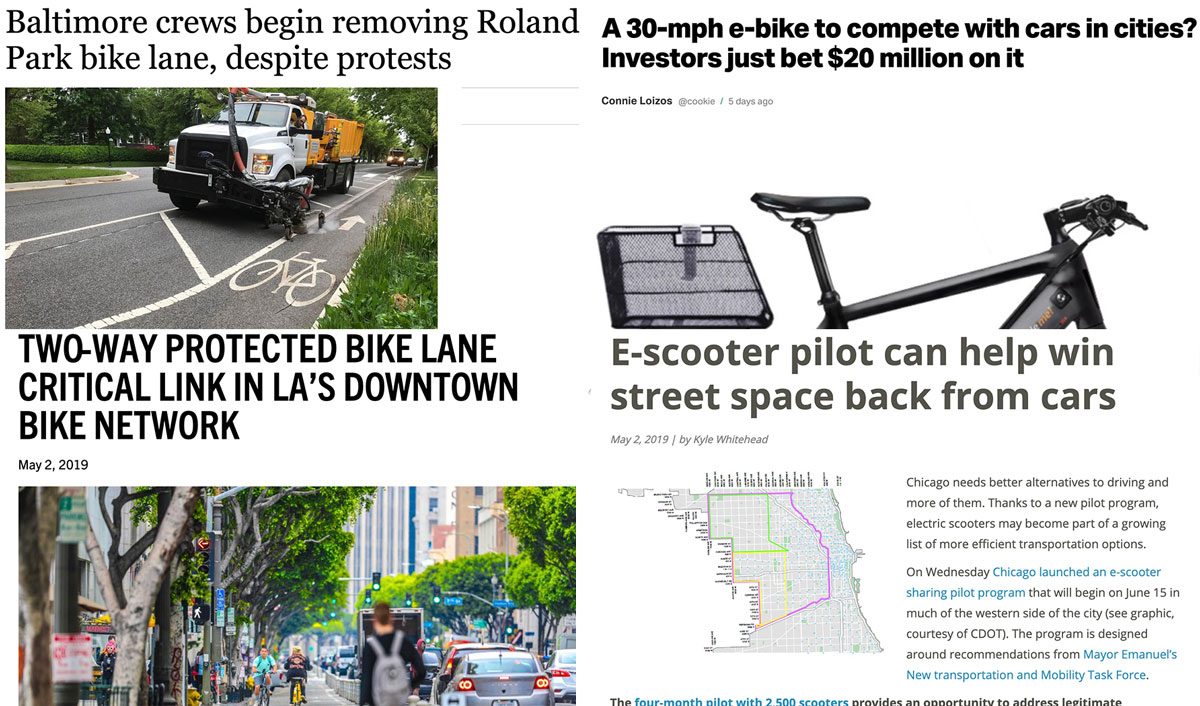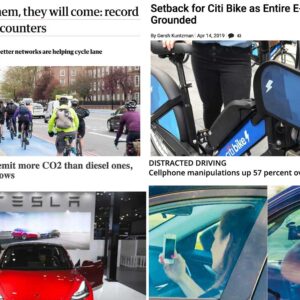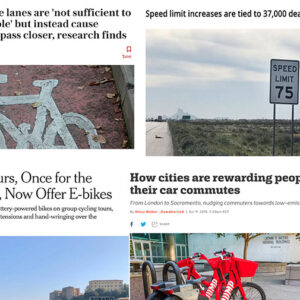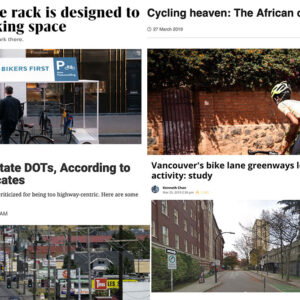This week’s Monday Roundup is brought to you by the Community Cycling Center, who invites you to their 25th anniversary Momentum Gathering this Friday May 10th!
Here are the most noteworthy items we came across in the past seven days…
Safely breaking the law: This excellent piece from David Alpert at Greater Greater Washington says that not all traffic laws are equal and pretending it’s safer for bicycle users to follow them is spurious.
Car storage is too cheap: WePark is a new initiative that aims to highlight the value of curbside real estate (a.k.a. on-street parking) and how absurd it is to give it away so cheaply to private car storage.
Bad Baltimore: When a politician says bicycling infrastructure must “work for all,” you know you’re about to get shafted. RIP Baltimore protected bike lane.
Welcome, scooter comrades: Chicago’s Active Transportation Alliance is welcoming e-scooters with open arms in hopes the new two-wheelers can join their fight against auto users for more dedicated roadway space.
Advertisement
L.A.’s new bikeway: Los Angeles has opened up a two-way protected bike lane on a major downtown street.
Mode shift goals are no longer enough: The world’s most iconic cycling city has announced plans to completely ban diesel and gas-powered vehicles by 2030.
Racing’s “Unicorn Prince”: Noted sportswriter Jason Gay has written a profile of the greatest bicycle racer of the current era: The incomparable Mathieu van der Poel.
Traffic injustice: A methodology that connected police data on traffic crashes to hospital records showed that older, lower-income, and people with black/brown skin are more often victims of traffic violence in San Francisco.
Protection matters: Not sure if we’ve shared this yet; but it bears repeating: New research shows the importance of physical protection (not parked cars, not paint) when it comes to bikeways.
Typical selfishness: Authorities in Germany have seized 120 high-end supercars that were allegedly racing on open roads at speeds up to 155 mph.
E-bikes for the win: I would love to see what would happen on our streets if we had access to high-performance, dockless electric bikes that could go 30 mph. How about a pilot of these PBOT?
— Jonathan Maus: (503) 706-8804, @jonathan_maus on Twitter and jonathan@bikeportland.org
Never miss a story. Sign-up for the daily BP Headlines email.
BikePortland needs your support.







Thanks for reading.
BikePortland has served this community with independent community journalism since 2005. We rely on subscriptions from readers like you to survive. Your financial support is vital in keeping this valuable resource alive and well.
Please subscribe today to strengthen and expand our work.
e-bike link isn’t right.
sorry! Fixed it. Here’s the link.
Here we are, trying to promote “20 is plenty” and now we have a 30 (or even 45) mph bikes for our Vision Zero streets. Obviously speed doesn’t kill, silly me, only large vehicles hitting smaller ones who shouldn’t be there in the first place. I’m sure these fast electric bikes have figured out their automatic anti-locking braking systems already, so they can stop suddenly like all cars currently do before they hit pedestrians moving at 3 mph, or make left-hooks with oncoming cars at intersections. And of course they have a new anti-distraction robo-driver function, when looking at the phone is so much more important than paying attention driving your bike at 45 mph. In traffic. In the city. With lots of other distracted drivers. And vulnerable pedestrians.
the speed of these things is obviously an issue, but their business models seem anything but sustainable, too. an interesting, if very brief, take on that here: https://radicalurbanist.substack.com/p/-future-of-micromobility-automobilitys
As the happy owner of a 20mph-limited ebike, I have no desire for my bike or any else’s to go 30mph. 20 is a good limit.
One could even say it was plenty.
Oh goodness, there is most certainly a difference between a 30 mph e-bike (rider plus bike weighs, what, 230 pounds?) and a 30 mph or faster car (2-3 tons) in terms of pedestrian risk. Look at the target area: there’s no where for the car to escape to unless the entire adjacent lane is clear, but the bike can slip through any 2-foot open space if the worst happens. Look at the conserved momentum transfer: 2-3 tons at 30 mph vs 230 pounds at 30 mph, and not all of the e-bike rider’s momentum will transfer to the pedestrian. BIG difference. Also, the person on the e-bike has actual skin in the game (ever crashed a bike at 30 mph? It leaves a mark, or so I’ve seen.) The motorist? Not so much. Need I mention that the person on the bike can see and hear what’s going on much better than the person in the car (usually with windows up, stereo on and/or playing with that vibrating toy thing they all have).
Comparing e-bikes, even 30 mph e-bikes, to cars and concluding that cars are better just makes no sense to me. That said, sure there will likely be an occasional fatality involving such e-bikes. I’m good with that, especially since if they replace cars in our urban environments the overall fatality rates are guaranteed to drop significantly, if only because of the reduction in toxic air but much more likely from reducing the absurd number of deaths caused by motorists on a daily basis (about 110 per day in the US).
I think this fuzzy line between ebikes and electric mopeds is a problem. There is nothing wrong with either one, but at some point an ebike becomes an electric moped and should be driven in the car lanes only and not parked in bike parking. The other day I locked my bike up next to an ebike with a giant vertical battery behind the seat post ( just like the NYC delivery bikes). The pedal drive train looked it was just for show . It had about a 30mm bottom bracket, a stamped front cog, and tiny molded pedals that looked like they came off a kids trike. It was an electric moped with a fake bike facade.
Exactly right. A 30 mph ebike would require changing the definition of ebike in the ORS:
ORS 801.258¹
“Electric assisted bicycle”
…
(5) Is equipped with an electric motor that:
(a) Has a power output of not more than 1,000 watts; and
(b) Is incapable of propelling the vehicle at a speed of greater than 20 miles per hour on level ground.
A bike that goes 30 mph unassisted would require am Oregon drivers license to operate, registration, and the rider would be required to wear a motorcycle helmet. Not really a bike anymore.
This handy chart puts all the things in one place:
https://www.oregon.gov/ODOT/Forms/DMV/6619.pdf
AND the use of the term “Mopeds” should go back to its origin: “Motorized + Pedalling”
…and then e-bikes should move into a reformed “moped” niche and ALL non peddled motorized petrol fuelled two wheelers (the current mopeds) should move into a new urban lower speed / single passenger “scooter” class..since almost no new “mopeds” have pedals anymore for either starting or propulsion…not like the 1960s/ 1970s. Motorcycles would stay happily where they are.
As I headed out this morning, an elderly obese woman on such an e-bike rolled across my view on the bike path. She wasn’t pedaling at all and at first I thought she was on an e-moped. On closer inspection, I realized that she was so infirm that the only way she could be out on the bike path was on such a machine. Her big smile as she sailed along at 20 mph on the nearly deserted path was all I needed to be supportive of her choice.
Funny enough, my wife encountered a man on a similar machine. He was also elderly and a bit infirm, but he was content to roll along slowly, perhaps because there were more people where he was riding. He turned off the path and rode up a nearby hill with a nice view. Without the e-bike, his only option for that view is a car. With the benefit of more speed, he can increase his safety where traffic moves faster than 20 mph (everywhere, really).
This is what’s in play. These are new riders. These are allies. These are voters. Tired of being “othered” because you ride bikes and support better facilities? Help these people get what they want, which is mostly e-bikes and sometimes faster e-bikes. A good friend (age 74, one arm only) rides an illegally suped-up e-bike because it’s the only way he can get his 300 pound body up to his grandson’s house with reasonable safety. We should legalize him (not that he cares).
We don’t need purity tests. Leave that stuff for the UCI and its racing standards.
Is anyone ever going to read that Australian study? It doesn’t look at protected facilities. It compares passing distance on notoriously awful door-zone bike lanes (where there shouldn’t be a bike lane in the first place because there isn’t room) to passing distances on roads that lack parked cars (and also lack bike lanes). Seriously, this makes no case at all for the statement that painted lanes aren’t enough or that “protected” lanes are better.
It does make the case that DZBL’s are horrible and encourage overly close passing, but we already knew that. That’s why experienced riders don’t ride in DZBL’s. We either route ourselves away from them or take the lane, as permitted when a hazard exists in the bike lane.
Let’s stop misrepresenting this work and use it for what it really says: Get rid of Door Zone Bike Lanes!
Bravo; most studies of painted bike lanes still find that they produce some safety benefits over having no markings at all, mainly because of the greater consistency in passing distances they engender (the smallest distances observed in the Aust study were on streets with NO markings). Here’s my take: http://cyclingchristchurch.co.nz/2019/04/26/do-closer-average-passes-mean-less-safe-cycling/
At 20MPH, you’re an elite sprinter, a faster-than-average cyclist, and extremely unlikely to have a fatal traffic collision. Just a thought here, but it seems like our bodies and brains are only evolved for the kind of speeds that humans can run.
Whatever good there is in a 30MPH e-bike, it is hard to imagine it outweighing the bad.
I could say the same thing about a family sedan that’s capable of 150mph.
This is a quote from the (some might say) typically selfish ebike article:
“Investors think the company might be right — at least, they think it might be right for a certain type of customer who wants to get to where she is going faster. ”
What? Hey, what happened to just leaving earlier, chilling out, Vision Zero?
Isn’t this the exact sort of behavior that has been vilified on this website when it pertains to car travel?
I know, right?
Jonathan, I’m curious for your response.
I don’t find 20 mph all that fast, and I’m definitely no elite sprinter. However, terrain makes all the difference; I might be able to stick to 20 for a minute or so on flat ground, but I do go much faster on even slight downhills. The real key is context. Would I go 30 mph down hill on a crowded or limited-visibility MUP? No. Would I pass a kid on a bike the same way I would pass an adult? No. Does the intoxicating rush of high-speed e-bike travel induce unsafe operation around slower cyclists or pedestrians? I don’t know. Have I ever ridden an e-bike? No.
The real trouble with “fast” e-bikes is not necessarily the raw speed, but the seemingly unnatural speed a “bicycle” like this can attain. I can usually identify the e-bikes I see because they look overly-heavy and clunky, with great huge knobby tires, yet fly along with no pedaling or an unnaturally slow pedal cadence—and the riders are usually way overdressed (subjective, I know). Do drivers with no riding experience have the ability to see a bike coming and properly judge its speed based on whether it is an e-bike going 30 or an old-fashioned bike going 15? If an untrained driver sees two bikes side-by-side, can they tell at a glance whether they are two riders going the same “normal” bike speed, or whether one is a 30-mph e-bike passing a poor shlub on an ATP-driven, 19th-century contraption?
It seems like super-fast bikes would mess with the assumptions and challenge the judgment of drivers and other VRUs alike.
Sorry e-bikes fans, it’s time for Motorized Bicycles to be licensed, registered, and insured. I can imagine a fair number of these belonging to persons who don’t own a car, therefore are not insured for liability, at all. I can also imagine a mamma and two babies in a stroller using the bike path on Powell (no sidewalk available) getting cut down by someone using the bike lane at 30 mph. I’m going to begin lobbying city, state & federal reps.
I am sure you will be pleased to learn that 30 mph ebikes already do you have all of the requirements you suggest.
The 30 mph ebikes certainly present complications for classification, where they should ride, etc. due to their speed. But it seems like the complications and problems arise if they’re viewed as bikes. That is, I’ve never had a problem with 20 mph ebikes in a bike lane, or going past me when I’m walking my dog on the Willamette Greenway Trail. But I don’t think 30 mph ebikes should mix with people on a trail in a park, or in a busy bike lane. You could theoretically have a 20 mph speed limit for them in those places, but I’m not sure that would work.
But if they’re on the street, as a replacement for a car, why not? The extra 10 mph is significant because it means people can ride in the lane on most streets, like a moped, scooter (Vespa-type), etc.
Basically, they seem worse than bikes but better than cars.
the view that has been pitched heavily is that safest means to mix modes is to slow down traffic …not to speed up the VRUs.
Having ebikes capable of 30 mph doesn’t preclude slowing traffic down. Cars go a lot faster than 20 mph also. The ebike rider can go 30 mph on a 30 mph street, then slow to 20 or less on slower streets.
I’m not really pushing for them. I’d never want one myself. I’m just trying to think the arguments through. I can also see where logically they should work (for instance the idea they can go slower where needed) but in practice they won’t (people will go 30 mph on places like shared trails where that speed isn’t safe, even if there’s a 20 mph or slower limit).